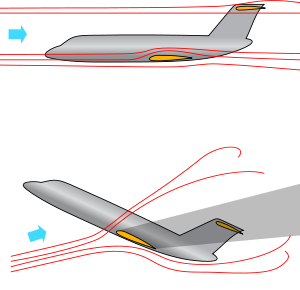
1966 Felthorpe Trident crash
Encyclopedia
The Felthorpe Trident crash occurred on 3 July 1966 when Hawker Siddeley Trident 1C
G-ARPY entered a deep stall from which the crew were unable to recover. The aircraft crashed at Felthorpe
, Norfolk killing all four crew. This was the first loss of a Trident aircraft.
 The flight was scheduled to be a routine test flight. There were four crew on board and the flight was being performed to enable the aircraft's Certificate of Airworthiness to be issued. The aircraft was making its first flight. The aircraft took off from Hatfield Aerodrome
The flight was scheduled to be a routine test flight. There were four crew on board and the flight was being performed to enable the aircraft's Certificate of Airworthiness to be issued. The aircraft was making its first flight. The aircraft took off from Hatfield Aerodrome
at 16:52. Tests established that the stick shaker
operated at 102 knots (199.9 km/h) and that stall recovery system operated at 93 knots (182.3 km/h). The crew then disconnected the stall warning systems in order to ascertain the actual margin left after the warning had been given before the aircraft stalled. On this particular flight, the aircraft was being operated with its centre of gravity towards its aft limit.
Shortly after 18:30, the aircraft was reported by Barlow to be in a "superstall". At the time the aircraft was observed to be configured for landing. It was at an altitude of 10000 feet (3,048 m). The nose was seen to pitch up by 30 to 40° before the aircraft turned to port, followed by the starboard wing dropping. Although full power was applied, the aircraft entered into a flat spin and crashed at Felthorpe
, killing all on board. It was not fitted with an anti-spin parachute. The site of the accident was in a field adjacent to Felthorpe Airfield. This accident was the first loss of a Trident.
Hawker Siddeley Trident
The Hawker Siddeley HS 121 Trident was a British short/medium-range three-engined jet airliner designed by de Havilland and built by Hawker Siddeley in the 1960s and 1970s...
G-ARPY entered a deep stall from which the crew were unable to recover. The aircraft crashed at Felthorpe
Felthorpe
Felthorpe is a civil parish in the English county of Norfolk.It covers an area of and had a population of 710 in 287 households as of the 2001 census.For the purposes of local government, it falls within the district of Broadland....
, Norfolk killing all four crew. This was the first loss of a Trident aircraft.
Accident Flight

Hatfield Aerodrome
Hatfield Aerodrome, formerly , was an airfield and aircraft factory located in the town of Hatfield, Hertfordshire from 1930 until its closure and redevelopment in the 1990s.-Early history:...
at 16:52. Tests established that the stick shaker
Stick shaker
A stick shaker is a mechanical device to rapidly and noisily vibrate the control yoke of an aircraft to warn the pilot of an imminent stall...
operated at 102 knots (199.9 km/h) and that stall recovery system operated at 93 knots (182.3 km/h). The crew then disconnected the stall warning systems in order to ascertain the actual margin left after the warning had been given before the aircraft stalled. On this particular flight, the aircraft was being operated with its centre of gravity towards its aft limit.
Shortly after 18:30, the aircraft was reported by Barlow to be in a "superstall". At the time the aircraft was observed to be configured for landing. It was at an altitude of 10000 feet (3,048 m). The nose was seen to pitch up by 30 to 40° before the aircraft turned to port, followed by the starboard wing dropping. Although full power was applied, the aircraft entered into a flat spin and crashed at Felthorpe
Felthorpe
Felthorpe is a civil parish in the English county of Norfolk.It covers an area of and had a population of 710 in 287 households as of the 2001 census.For the purposes of local government, it falls within the district of Broadland....
, killing all on board. It was not fitted with an anti-spin parachute. The site of the accident was in a field adjacent to Felthorpe Airfield. This accident was the first loss of a Trident.

